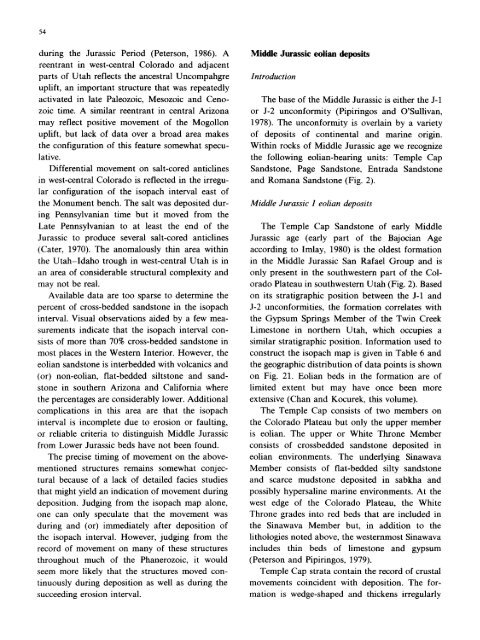Synthesis of late Paleozoic and Mesozoic eolian deposits of the ...
Synthesis of late Paleozoic and Mesozoic eolian deposits of the ...
Synthesis of late Paleozoic and Mesozoic eolian deposits of the ...
You also want an ePaper? Increase the reach of your titles
YUMPU automatically turns print PDFs into web optimized ePapers that Google loves.
54<br />
during <strong>the</strong> Jurassic Period (Peterson, 1986). A<br />
reentrant in west-central Colorado <strong>and</strong> adjacent<br />
parts <strong>of</strong> Utah reflects <strong>the</strong> ancestral Uncompahgre<br />
uplift, an important structure that was repeatedly<br />
activated in <strong>late</strong> <strong>Paleozoic</strong>, <strong>Mesozoic</strong> <strong>and</strong> Ceno-<br />
zoic time. A similar reentrant in central Arizona<br />
may reflect positive movement <strong>of</strong> <strong>the</strong> Mogollon<br />
uplift, but lack <strong>of</strong> data over a broad area makes<br />
<strong>the</strong> configuration <strong>of</strong> this feature somewhat specu-<br />
lative.<br />
Differential movement on salt-cored anticlines<br />
in west-central Colorado is reflected in <strong>the</strong> irregu-<br />
lar configuration <strong>of</strong> <strong>the</strong> isopach interval east <strong>of</strong><br />
<strong>the</strong> Monument bench. The salt was deposited dur-<br />
ing Pennsylvanian time but it moved from <strong>the</strong><br />
Late Pennsylvanian to at least <strong>the</strong> end <strong>of</strong> <strong>the</strong><br />
Jurassic to produce several salt-cored anticlines<br />
(Cater, 1970). The anomalously thin area within<br />
<strong>the</strong> Utah-Idaho trough in west-central Utah is in<br />
an area <strong>of</strong> considerable structural complexity <strong>and</strong><br />
may not be real.<br />
Available data are too sparse to determine <strong>the</strong><br />
percent <strong>of</strong> cross-bedded s<strong>and</strong>stone in <strong>the</strong> isopach<br />
interval. Visual observations aided by a few mea-<br />
surements indicate that <strong>the</strong> isopach interval con-<br />
sists <strong>of</strong> more than 70% cross-bedded s<strong>and</strong>stone in<br />
most places in <strong>the</strong> Western Interior. However, <strong>the</strong><br />
<strong>eolian</strong> s<strong>and</strong>stone is interbedded with volcanics <strong>and</strong><br />
(or) non-<strong>eolian</strong>, flat-bedded siltstone <strong>and</strong> s<strong>and</strong>-<br />
stone in sou<strong>the</strong>rn Arizona <strong>and</strong> California where<br />
<strong>the</strong> percentages are considerably lower. Additional<br />
complications in this area are that <strong>the</strong> isopach<br />
interval is incomplete due to erosion or faulting,<br />
or reliable criteria to distinguish Middle Jurassic<br />
from Lower Jurassic beds have not been found.<br />
The precise timing <strong>of</strong> movement on <strong>the</strong> above-<br />
mentioned structures remains somewhat conjec-<br />
tural because <strong>of</strong> a lack <strong>of</strong> detailed facies studies<br />
that might yield an indication <strong>of</strong> movement during<br />
deposition. Judging from <strong>the</strong> isopach map alone,<br />
one can only specu<strong>late</strong> that <strong>the</strong> movement was<br />
during <strong>and</strong> (or) immediately after deposition <strong>of</strong><br />
<strong>the</strong> isopach interval. However, judging from <strong>the</strong><br />
record <strong>of</strong> movement on many <strong>of</strong> <strong>the</strong>se structures<br />
throughout much <strong>of</strong> <strong>the</strong> Phanerozoic, it would<br />
seem more likely that <strong>the</strong> structures moved con-<br />
tinuously during deposition as well as during <strong>the</strong><br />
succeeding erosion interval.<br />
Middle Jurassic <strong>eolian</strong> <strong>deposits</strong><br />
Introduction<br />
The base <strong>of</strong> <strong>the</strong> Middle Jurassic is ei<strong>the</strong>r <strong>the</strong> J-1<br />
or J-2 unconformity (Pipiringos <strong>and</strong> O'Sullivan,<br />
1978). The unconformity is overlain by a variety<br />
<strong>of</strong> <strong>deposits</strong> <strong>of</strong> continental <strong>and</strong> marine origin.<br />
Within rocks <strong>of</strong> Middle Jurassic age we recognize<br />
<strong>the</strong> following <strong>eolian</strong>-bearing units: Temple Cap<br />
S<strong>and</strong>stone, Page S<strong>and</strong>stone, Entrada S<strong>and</strong>stone<br />
<strong>and</strong> Romana S<strong>and</strong>stone (Fig. 2).<br />
Middle Jurassic I <strong>eolian</strong> <strong>deposits</strong><br />
The Temple Cap S<strong>and</strong>stone <strong>of</strong> early Middle<br />
Jurassic age (early part <strong>of</strong> <strong>the</strong> Bajocian Age<br />
according to Imlay, 1980) is <strong>the</strong> oldest formation<br />
in <strong>the</strong> Middle Jurassic San Rafael Group <strong>and</strong> is<br />
only present in <strong>the</strong> southwestern part <strong>of</strong> <strong>the</strong> Col-<br />
orado P<strong>late</strong>au in southwestern Utah (Fig. 2). Based<br />
on its stratigraphic position between <strong>the</strong> J-1 <strong>and</strong><br />
J-2 unconformities, <strong>the</strong> formation corre<strong>late</strong>s with<br />
<strong>the</strong> Gypsum Springs Member <strong>of</strong> <strong>the</strong> Twin Creek<br />
Limestone in nor<strong>the</strong>rn Utah, which occupies a<br />
similar stratigraphic position. Information used to<br />
construct <strong>the</strong> isopach map is given in Table 6 <strong>and</strong><br />
<strong>the</strong> geographic distribution <strong>of</strong> data points is shown<br />
on Fig. 21. Eolian beds in <strong>the</strong> formation are <strong>of</strong><br />
limited extent but may have once been more<br />
extensive (Chan <strong>and</strong> Kocurek, this volume).<br />
The Temple Cap consists <strong>of</strong> two members on<br />
<strong>the</strong> Colorado P<strong>late</strong>au but only <strong>the</strong> upper member<br />
is <strong>eolian</strong>. The upper or White Throne Member<br />
consists <strong>of</strong> crossbedded s<strong>and</strong>stone deposited in<br />
<strong>eolian</strong> environments. The underlying Sinawava<br />
Member consists <strong>of</strong> flat-bedded silty s<strong>and</strong>stone<br />
<strong>and</strong> scarce mudstone deposited in sabkha <strong>and</strong><br />
possibly hypersaline marine environments. At <strong>the</strong><br />
west edge <strong>of</strong> <strong>the</strong> Colorado P<strong>late</strong>au, <strong>the</strong> White<br />
Throne grades into red beds that are included in<br />
<strong>the</strong> Sinawava Member but, in addition to <strong>the</strong><br />
lithologies noted above, <strong>the</strong> westernmost Sinawava<br />
includes thin beds <strong>of</strong> limestone <strong>and</strong> gypsum<br />
(Peterson <strong>and</strong> Pipiringos, 1979).<br />
Temple Cap strata contain <strong>the</strong> record <strong>of</strong> crustal<br />
movements coincident with deposition. The for-<br />
mation is wedge-shaped <strong>and</strong> thickens irregularly

















